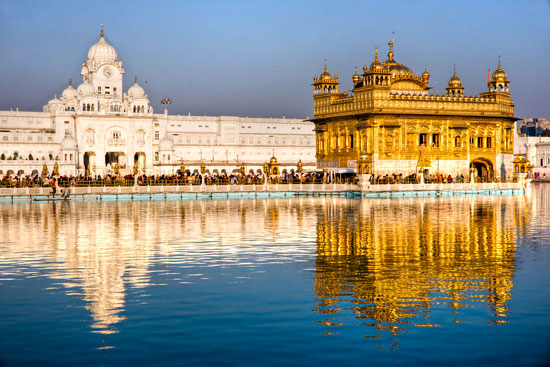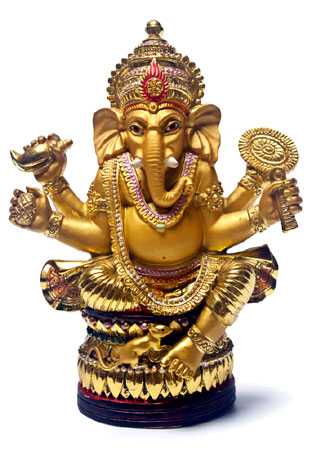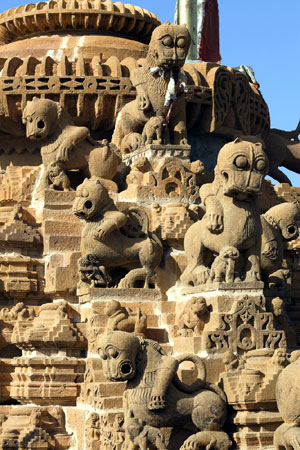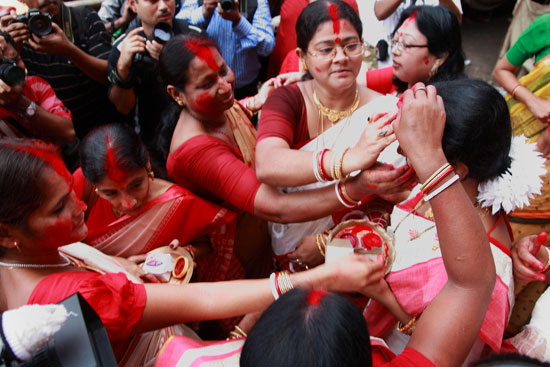Culture and Society: Religion Overview
Religions of the Country
India is the birthplace of several major religions, including Hinduism, Buddhism, Jainism, Sikhism, and a multitude of smaller religions. You can find most of the world’s other major religions practiced there in large numbers as well.
Hinduism, India’s predominant religion, claims a following of a little more than 80 percent of the country’s population. The Indian government tends to classify followers of indigenous tribal religions, who are usually animists, as Hindus, so this figure is somewhat inflated. The size of India’s Muslim population (about 13 percent of all citizens) is second only to the Muslim population of Indonesia and is larger than that of neighboring Islamic Pakistan. Christianity has a small following of the population, as does the Sikh religion. Other religions, such as Buddhism, Jainism, Zoroastrianism, Judaism, and Baha’i, have a combined following of just over 1 percent of the population.
Basic Tenets of Hinduism
The basic tenets of Hinduism include a belief in Iswara (Supreme Lord) in triune aspect: Brahma, the creator; Vishnu, the preserver; and Shiva, the destroyer. The worship of the creator Brahma is limited since, his work is supposedly finished, at least for this Yuga (Eon). Most Hindus are Vaishnavaites, who worship Vishnu and nine of his various incarnations such as Ram, Krishna, and Narasimha. Shiva is the principal deity for a large number of Hindus (Shaivaites), especially in the South. Hindus worship the Shakthi, the Mother Goddess or feminine Divine, under various names such as Parvati, Durga, Kali, or Mahalakshmi.
Hinduism lays emphasis on certain values consisting of Dharma (the ethics, duties, and obligations of every individual), Samsāra (rebirth), Karma (action and reaction, causation), and Moksha (salvation). A person can attain salvation by following a variety of paths such as Bhakti Yoga (the path of devotion), Karma Yoga (the path of action), Rāja Yoga (the path of meditation), and Jñāna Yoga (the path of knowledge).
Hinduism also propagates the practice of Chathur Varna (literally, "the four colors"), or the Caste System, one of the most contentious issues in Hinduism today. This system divides society into four castes: the Brahmins (priests and scholars), Kshathrias (warriors and rulers), Vaishyas (farmers and merchants), and Sudras (menial workers). The first three castes are also known as "twice-born" and they have the privilege of wearing the "sacred thread." Those outside the four castes are the "outcastes," formerly known as "untouchables" and now dignified by the appellation of Dalits.
Hinduism teaches that man is constantly reborn after death and that the life form that he assumes in the next life depends on the actions done in this life. Evil actions will result in the person being reborn as a lower life form or into a lower caste. Good actions cause the soul to be born into a higher caste or take it closer to the Supreme Divine, leading to a birth with a higher consciousness. The ultimate goal is to keep being reborn higher and higher in consciousness until one joins the Supreme Divine and escapes from the cycle of birth and death.
Hindus worship a multitude of devas and devis (male and female celestial beings or deities), who are distinct from the three main gods.
Basic Tenets of Minority Indian Religions
Jainism is a religion that is roughly contemporary to Buddhism and bears much resemblance to it in its commitment to ahimsa, or compassion toward all living things, and the belief in reincarnation and eventual spiritual salvation or moksha. The Jain reverence for all life requires the scrupulous avoidance of injury to all living things, so all Jains are vegetarians. Some cover their mouths with a piece of cloth to avoid the risk of accidentally swallowing an insect and walk in the streets with a broom to clear their way of any small creatures that they might accidentally injure.
The Jains are divided into two sects, the Shvetembara and the Digambara. Shvetambara Jains vow to avoid injury, lying, and stealing and must make a pilgrimage to one of the sacred Tirthas (Mount Abu, Mount Samneta, Mount Girnar, Mount Shatrunjaya). Mount Shatrunjaya, the most meritorious of the Tirthas, is a vast temple with more than 1,000 shrines and 800 temples. The Digambaras are more austere sect, confined to monasteries, who wear no clothes as a sign of their contempt for material possessions.
The principal belief in Sikhism is faith in the Vāhigurū, or the teachings of the ten Sikh gurus and the Granth Sāhib, a holy scripture that includes the selected works of many authors from diverse backgrounds. Sikh teachings emphasize Simran, the repeating of spiritual songs aloud or silently with each breath, Seva, giving one's time in selfless service, Dharam Di Kirt Karna, earning one's living righteously, and Dharam Di Kirt Karna, sharing what one has with others. The five kakkars, or symbols of Sikh faith, are kesha (uncut hair), kangha (a wooden or ivory comb), kaccha (special underwear), kara (a steel bracelet), and the kritipan (a short sword). The five "thieves," or emotions a Sikh must avoid, are lust (kham), anger (krodh), greed (lobh), attachment (moh), and ego (ahankar). The five weapons, or virtues, to be used against these "thieves" are compassion (daya), truth (sat), contentment (santokh), humility (nimrata), and love (pyare).
The founder of Sikhism, Guru Nanak, advocated one God who is neither a Hindu nor a Muslim, but simply Sat, or "truth." Sikhs are opposed to the caste system and prefer meditation to rituals. They worship at temples called Gurdwaras, baptize their children when they are old enough to understand the principles of the religion in a ceremony called Pahul,and cremate their dead.
Spiritually Devout or Nominal
India is a deeply religious country where religious beliefs and spirituality have a very high value. Although there are purely nominal Hindus, most of them take part in the various Hindu festivals and observe Hindu customs in their daily lives. A large number of people, Christians and Muslims in particular, attend weekly religious services.
A very large percentage of the Indian population is devout, with Hindus worshipping almost everything, from mountains to rivers, stones, trees, animals, and even certain people, like Guru Sai Baba, for example. Another indication of this devout nature is the millions of temples and idols that dot the Indian landscape. While very devout Hindus go the temple every week, most wait for the arrival of a festival or ritual to attend temple services.
Religious Conflict
While India’s many religions generally co-exist peacefully in many areas, religious clashes occur frequently in others. The country has a history of animosity between the Hindus and Muslims and, to a lesser degree, between Hindus and Christians. Each year sees violent attacks by Muslims on Hindus and vice versa, as well as by Hindus on Christians. However, there are virtually no cases of attacks by Christians on other religious groups in India. Fundamentalists and extremists in Hinduism and Islam carry out many of these attacks. The demolition of the Babri Masjid mosque at Ayodhya in Uttar Pradesh in 1992 by an estimated 100,000 to 150,000 Hindus caused widespread communal riots that killed thousands of people from both religious communities. Another incident started after a train fire in Godhra, Gujarat, claimed the lives of 59 Hindu men, women, and children. Although Muslims were not responsible (a Railway inquiry later established the cause as fire from a stove), anti-Muslim violence resulted in the deaths of thousands of Muslims, with hundreds more injured and raped.
Secularism
A strong secular movement is spreading across India, thanks to the efforts of leftist and liberal intellectuals. The main aim of this movement is to educate the population and increase awareness of the danger that fundamentalist religious forces pose to the country. This movement is of recent origin and its followers mostly belong to the upper financial and educational strata of society.
Superstitions
The religious history of India is long and replete with religious superstition. The superstitious beliefs of Hindus are almost too many to number. For example, a common practice is to present gifts of gold and silver, sometimes in the shape of the affected body part, to temples in order to beget a child or to be healed. To make a decision, a person might draw lots or place flowers in a temple and watch which way the wind lifts them.
Other practices are to make the first drive in a new vehicle straight to a temple, use the first milk from a newly bought cow to anoint a deity, and walk or roll on the ground for long distances as a way to thank a deity.
Certain superstitions are specific to certain localities, such as the belief in the town of Thenbaranadu, which belongs to the district of the Trichy in Tamil Nadu, that a person sent to select a bride must give up his mission if he comes across bamboo, firewood, a reptile, or the sounds of a deer.
Superstitions among the country’s Christians include the belief that offering a candle in the shape of the ailing organ to the shrine of Our Lady of Health at Velankanniwill cure the sufferer of the ailment.
Religious Clerics
Religious clerics are highly respected in Indian society and generally have immense power over their followers. However, a series of scandals involving religious leaders in recent times has seen a sense of disillusionment creep into a section of the populace. Another factor that has alienated people is the revelation that politicians and religious leaders tend to enter into unholy alliances that require the politician to appease the religious leaders, who, in turn, support the politician by influencing their followers.
Religious clerics generally attend religious schooling at institutions run by the country’s various religions, including Christian seminaries and Islamic theological schools. Most clerics also attend informal classes, usually conducted by gurus (religious teachers). However, formal educational qualifications are not necessary in order for a person to attain Hindu priesthood except the ability to chant the Sanskrit mantras (sacred devotional words).
The government does not officially regulate religious clerics or financially support them. Institutions run by minority religious groups have statutory protection, however, and enjoy a certain level of additional privileges.
Religion and Public Life
Religious beliefs play such a vital role in the lives of Indians that they take almost all major decisions after consulting astrologers or religious leaders. The importance of religion is evident in the very public, free-spirited way that Indians usually celebrate their religious festivals. In fact, religious festivals or pilgrimages are often the highlights of the year for a typical Indian family. Almost all schools begin their day with a public prayer session that all students attend.
Religious Holidays and Ceremonies
There are many important religious customs in the life of an Indian, including making pilgrimages to certain holy places around the country. These can range from temples atop mountains to sacred rivers. Bathing in a holy river, such as the Ganges, is considered especially meritorious. Another custom relates to removing the images of gods from their shrines and carrying them around their localized areas on carts or palanquins. Large crowds often follow these images to pray and offer homage to the idols. Most major officially recognized national holidays in India are religious in nature, and there are many of them.
The religious holidays of minority religions are officially recognized and celebrated. The most important national religious holidays include Krishna Jayanti (the birthday of Krishna), Diwali (the "festival of lights" commemorating the day Krishna killed the demon Narakasura), Dussehra (commemorating the day Rama defeated Ravana), and Ganesh Chathurthi (the birthday of Ganesha)for the Hindus; Christmas and Easter for the Christians; Eid-ul-Fitr and Eid-ul-Adha for the Muslims; Guru Nanak’s and Guru Govind Singh’s birthdays for the Sikhs; Mahavir Jayanti (the birthday of the founder of Jainism) for the Jains; and Buddha Jayanti (the birthday of the Buddha)for the Buddhists.
Government and Religion
India is constitutionally a secular country, and the Indian government has no formal affiliation to any religion or religious sect. While the federal government generally respects this freedom in practice, state governments ruled by Hindu nationalist parties sometimes chose to support, overtly or covertly, their religion. Support for or against any religion is not mentioned in any Constitutional or legal documents. However, there are laws that deal specifically with certain religious communities and lay out rules involving practices like marriage and divorce. Examples include the Hindu Marriage Act, the Indian Christian Marriage Act, and the Muslim Personal Law (Shari’a) Application Act. There is a formal separation between religion and the state, although the government considers religious sensitivities before making any major decision that affects a religious group.
India’s second largest political party, the Bhāratīya Janǎtā Party (BJP), has an openly pro-Hindu agenda and has often faced accusations of supporting Hindu nationalist forces at the expense of people belonging to minority religions. The states of Rajasthan and Madhya Pradesh (BJP-led) and Tamil Nadu have all passed laws restricting religious conversions in order to prevent Dalits, Hindu untouchables, from converting to Buddhism, Christianity, and other Indian religions through increasingly popular mass conversion ceremonies. BJP-led Gujarat has reclassified Buddhism and Jainism as branches of the Hindu religion in an attempt to maintain the Hindu majority in that state.
Persecution
The Indian government does not persecute outside religions, and religious proselytizing is generally legal. However, a couple of states have unsuccessfully attempted to bring in anti-conversion laws as a means to curb the practice. Conversion from religion to religion, especially from Hinduism to other religions, is a highly contentious issue in India. Christian missionaries have faced accusations of luring converts, especially the very poor, with promises of free healthcare services and education.
Foreign missionaries and evangelical groups can practice in the country, but they must register at the local police station before they can start their work. In addition, under the Foreigner’s Act, foreigners visiting the country on a tourist visa cannot indulge in religious preaching without obtaining permission from the Ministry of Home Affairs. However, foreign religious television channels can freely broadcast their programs in the country.
The possession and display of religious items and materials is legal, but the display of religious items offensive to another religious community is prohibited.
Religious Tolerance
India has a record of numerous religious clashes, mostly between the Hindu and Muslim communities. While most of the general population are tolerant of other religions, these clashes are often carried out by fundamentalists belonging to various religious groups. Hindu fundamentalist organizations are generally intolerant towards Muslims and Christians because they view their activities as being "anti-national." In a few states, the police and local authorities have sometimes aided these organizations in carrying out violent attacks against religious minorities.
Christian and Islamic missionaries are criticized for deceiving poor people and bribing them to convert with promises of financial assistance. At times, this criticism has escalated to cases of extreme violence where missionaries were beaten and even murdered. One famous example was the burning to death of an Australian missionary, Graham Steins, and his two sons in Orissa.
Protocols for Foreigners
There are a few religious caveats that foreigners should be aware of when visiting India. The cow is sacred in India for many Hindus who, especially in North India, do not eat beef. Damaging an idol or depicting a Hindu god or goddess in a derogatory manner is highly offensive.
Foreigners are free to participate in the country’s religious activities and rituals, although there are a few Hindu temples that ban the entry of foreigners and Indians belonging to other religions.
Copyright © 1993—2025 World Trade Press. All rights reserved.

 India
India 



